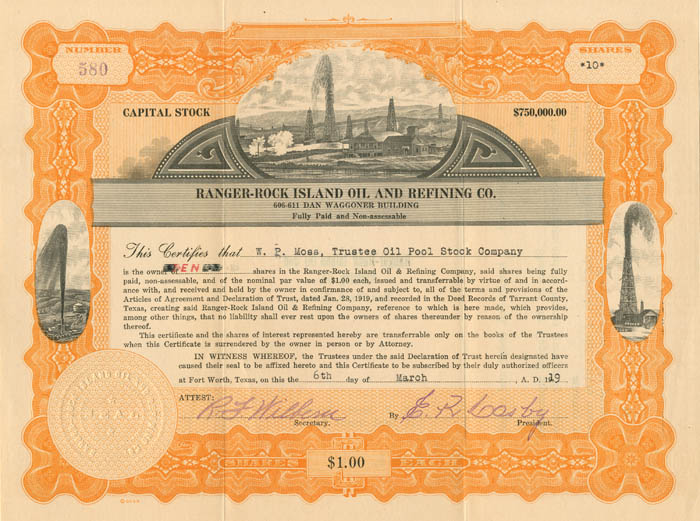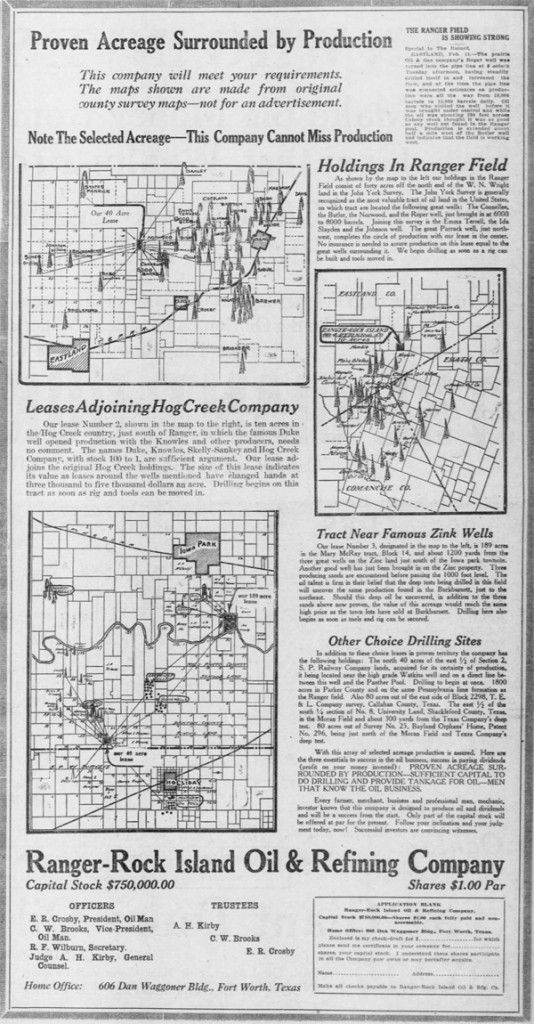 By the beginning of the 20th century, Texas wildcatters had fruitlessly pursued oil between Abilene and Fort Worth. They drilled mostly dry holes until 1917 when a gusher brought thousands to the arid region of cattle, cotton and mesquite trees.
By the beginning of the 20th century, Texas wildcatters had fruitlessly pursued oil between Abilene and Fort Worth. They drilled mostly dry holes until 1917 when a gusher brought thousands to the arid region of cattle, cotton and mesquite trees.
In October 1917, the McClesky No. 1 well in Eastland County revealed a massive oil-bearing sand 3,432 feet deep. The “Roaring Ranger” discovery made headlines worldwide just six months after America’s entry into World War I.
A find in nearby Desdemona soon added to North Texas oil discoveries. “The tiny peanut-farming hamlet of Desdemona in Eastland County was transformed when oil was struck in 1918,” noted one Texas historian. “Tents and shacks sprang up all around the town to house speculators and workers who flocked to the area.”
Located along Hog Creek, Desdemona (once called Hogtown) and the Ranger oilfield attracted new companies, some with little or no oil-patch experience. Among many others, the Hog Creek Carruth Oil Company profited by enthusiastically advertising stock sales to unwary investors.

A detail from one of Ranger-Rock Island Oil and Refining’s circa 1920 newspaper ads (see below).
Ranger-Rock Island Oil and Refining
Eager to drill in the Ranger oilfield, E.R. Crosby, C.W. Brooks and A.H. Kirby formed the Ranger-Rock Island Oil & Refining Company in Fort Worth, Texas. With Crosby named president, the company was capitalized at $750,000.
By February 1919, half-page advertisements in the El Paso Herald solicited investors, noting the company’s leases were in close proximity to proven oil-producing wells.
“Every farmer, merchant, business and professional man, mechanic, and investor knows that this company is designed to produce oil and dividends and will be a success from the start,” declared the company’s newspaper ads.
A map illustrated proposed drill sites. “Note The Selected Acreage – This Company Cannot Miss Production,” the company crowed about its 40-acre lease northeast of Eastland. The ad included a convenient cut-out application to send with a check for purchasing stock at $1 per share.
Another map depicted Ranger-Rock Island Oil’ and Refining’s second lease south of Ranger – “in the Hog Creek country” – declaring that “drilling begins on this tract as soon as rig and tools can be moved in.”
Success came west of Fort Worth when Ranger-Rock Island Oil and Refining’s Wright No. 1 well reached 3,483 feet into the McClesky sand (by September 8, 1919, daily production was 3,000 barrels of oil). Then the Wright No. 2 well was completed for 2,700 barrels a day. Another oil strike soon followed.
“The headliner of the Ranger pool, the W.W. Wright No. 3 of the Ranger-Rock Island Oil [and Refining] Company came in with an initial flow 1,700 barrels of oil at around the 3,500 foot level,” noted the Oil & Gas News. “This is the third producing well brought in by that company.”
By April 1920, Ranger-Rock Island Oil and Refining had drilled three successive producing wells, but total production had dropped from an initial 8,000 barrels a day to only 1,400 barrels a day. The Ranger oilfield was being depleted by overproduction and the company was feeling it. As drilling and production costs rose, oil prices fell from about $3 a barrel at the beginning of 1920 to less than $1.75 by the end of the year.
By 1921, Oil Distribution News reported that Ranger-Rock Island Oil and Refining shares, originally sold at one dollar each, were being bid at 50 cents per share by stock traders. After investor litigation in 1924, the company disappeared from financial records.
Among others also seeking riches in the Ranger oilfield was a young World War I veteran, Conrad Hilton. Witnessing roughnecks waiting in line at an Eastland County motel convinced him to purchase what became the first Hilton Hotel.
Read about another North Texas discovery, the 1911 April Fool’s day oil gusher near Electra, Texas, that would help earn that town the title of “Pump Jack Capital of Texas.”

___________________________________________________________________________________
The stories of other attempts to join petroleum exploration booms (and avoid busts) can be found in an updated series of research at Is my Old Oil Stock worth Anything?
Please support the American Oil & Gas Historical Society and this website with a donation.

